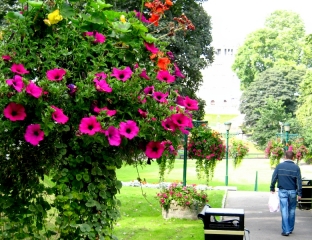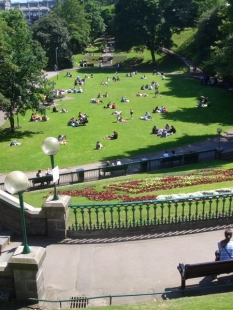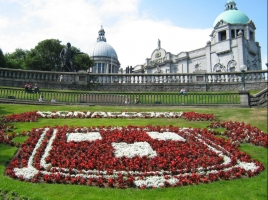Voice’s Old Susannah takes a look over the past week’s events in the ‘Deen and beyond. By Suzanne Kelly.
Tally Ho! For a city with no beating heart and collapsed lungs awaiting a granite web transplant, Aberdeen is somehow managing to hold its own on the cultural front. The Techfest 2014 events are very impressive and are still ongoing. Aberdeen gets ready to welcome Billy Connolly next week; if the city isn’t rolling out the red carpets, it should be.
The Big Yin will be at the music hall; tickets sold out instantly. Post referendum, this will be quite a show. That underused shady green garden is going to have an Oktoberfest. It’s all happening.
Referendum fallout is everywhere, and shows no signs of abating. Both Yes and No camps still cry foul; queens are accused of purring; political parties are accused of breaking their promises, something I can assure worried readers will never happen.
Two years on, and Aberdeen’s own referendum on Union Terrace Gardens show no sign of abating, either. The P&J, Tom Smith, ACSEF and Sir Ian Wood are still banging on about how a granite web is the city’s only salvation and how it must be built over our only existing city centre green space (coincidentally owned by you and I, and worth tens of millions).
The canals of Venice. The Eiffel Tower.The Taj Mahal. The granite web to nowhere. Yes, that would have worked. These tenacious people of course have no selfish interests as they campaign on and on and on.
In the news this week are various movements – various ‘isms’. Women are bleating on about wanting rights. Campaigning journalists closer to home are drumming up support for their advertisers’ projects – sorry – important local causes. Time for a look at some of these ‘isms’.
Feminism: (Modern English movement) – belief that women and men should have equal opportunities, equal rights and equal pay.
Well, I am just a weak, helpless female, so I got one of my male colleagues to explain to me what’s wrong with this feminism business. Apparently, it’s all about unshaven women who want to look like men, or something like that. It’s just too complex for me.
On the other hand, I did some research. You will be surprised to learn that there may indeed be instances where there is a small amount of discrimination.
For reasons known only to herself, actress Emma Watson – actress and academic scholar is trying to tell us that feminism isn’t a dirty word. For some reason, she thinks that women are not treated as well as men. I wonder why she’d come to such a wild conclusion; she’s probably just looking for headlines.
Of course Watson may object to a few inconsequential facts. Women around the world do not earn as much money as male contemporaries for the same work. Women are being forced into marriage around the globe including here in the UK. There is also the small matter that in the western world, a mere one in 4 women can expect to experience some form of sexual abuse or violence.
Women are being trafficked against their will to be used as prostitutes. Police routinely ignore women’s pleas for help with domestic violence, and yet another woman in the UK was killed by a stalker the police had been warned about many, many times before.
That ought to prove that women aren’t subject to exploitation
In short, I’ve no idea why Emma thinks that campaigning for equal treatment of women in society is something we need to do. But wouldn’t it be wonderful if she turned her efforts to something worthwhile, like backing the Aberdeen City Garden Project?
To disprove Watson’s case, some charming, anonymous people have started a countdown online as to when they plan to release nude photos of her. That ought to prove that women aren’t subject to exploitation to everyone’s satisfaction. Releasing any photos will also put her back in her place, intimidate her, and then we girls can forget all this silly feminist stuff.
For further examples of the fair treatment the fair sex gets, the 25/9 P&J carries a tale we can all have a good laugh along with.
Offshore worker Andrew Thomas has unfairly been put on the sex offenders’ register for a whole year, and will have to do some community service. He was just being a lad after all when he snuck into his female offshore co-worker’s room, set up a phone to spy on her, and saved photos of her changing and washing. It’s even funnier because he pretended to be her pal.
Any red-blooded offshore worker would have done the same. Spoilsport Kerry McKnockiter doesn’t get that this was just good fun, and somehow feels she’s been violated. Go figure. At the same time, a man who grew something called ‘marijuana’ at his home has rightly been locked up for 12 months, a splendidly fair sentence, and a great use of taxpayer money. Good on us.
As to this equal pay business that feminists want resolved, what do you need money for once you’ve got a husband, hopefully the richest one you could snare? I’d recommend pretty young girls enter beauty contests – look at the great catch Sarah ‘Face Of Aberdeen’ Malone landed when Damian Bates married the lucky girl?
Still, some women insist on working, taking jobs away from our boys. It’s only right that girls don’t get the same money as men do; after all, they’re not as strong or as smart as men are. All public sector pay was meant to be levelled out years back; this is still in progress. In fact, Torry was once asked to sell huge tracts of land it controlled to help Aberdeen City level out its pay issues.
If Old Susannah recalls correctly (remember, I’m just an old woman) – the city made a fine job of equalising pay – by lowering the salaries of some men, rather than raising women’s pay. Sounds pretty reasonable to me. More on all this here. Of course pay and pension are still wee problems (well, if you’re a girl anyway) today. All I can say is ‘calm down dear, it’s only your living wage.
We’ve had wimmin academics heckled, threatened with rape and other forms of violence.
It couldn’t be that the ‘writers’ are slavishly regurgitating whatever press releases it gets
I guess when you have extremist feminists like Caroline Criado-Perez (a foreigner, note) who wanted Jane Austin put on a bank note, then trying to frighten the weaker sex is a good strategy to get them in line.Perhaps a nice cup of tea and a pat on the head is all that these feminist type ladies and Emma Watson need.
That, and perhaps a box of chocolates and a new hat.
Yellow Journalism: The use of sensationalism, bias, and exaggeration in order to attract and/or influence readers.
“There are no concrete plans to breathe new life into the heart of Aberdeen – two years after the city Garden Project was controversially scrapped.”
– So wrote the P&J’s Dawn Morrison this week for the P&J’s Wednesday cover story, dramatically illustrated with an ornate gold picture frame with nothing inside of it. I’m sure this factual, un-emotive opening sentence will have us girls weeping into our ice-cream tubs.
I’m equally sure that, coincidentally of course, some of the P&J’s biggest advertisers do indeed have concrete plans for Union Terrace Gardens.
Well, perhaps granite-clad concrete is what they want, but there are some people who just want that green space taken over, which will magically put the business rates in the area within the reach of local shopkeepers, will reduce the unfair advantages multinational competitors have over homegrown businesses (buying power, advertising, brand recognition, and of course the use of cheap if not slave labour abroad to create projects).
It’s also very reassuring that all P&J writers, off their own bats of course, use the exact same description for Aberdeen – breathing new life into it, its beating heart, etc. etc.
It couldn’t be that the ‘writers’ are slavishly regurgitating whatever press releases or directives they get. It wouldn’t be like helmsman Damian Bates to dictate to his minions what to write, what not to write about (Anthony Baxter and his Trump-related documentaries for instance) or how to write it.
A google search on ‘breath new life’, ‘heart’, ‘Aberdeen’ and ‘Ian Wood’ will give you all the breathing, beating and throbbing you could ever hope for. It’s just amazing everyone uses the same metaphors – not that these stirring words and phrases are getting at all tedious or worn out, mind you. This whole business may have started with Sir Ian himself; and a regular breath of fresh air he is, too.
The P&J is a bastion for free thinking, freely-writing intrepid investigative journalists whose high ideals lead to balanced articles such as this empty picture frame one. Some might think that such a blatant piece of editorial belongs tucked away inside the issue, but that’s another matter. Some also think that the press shouldn’t exist to serve its advertisers’ interests or indeed the financial interests of the people who edit the news. But that is, I suppose, nit-picking.
Alas, that’s all there is time for this week; I feel the need to shop coming on, and my weakly female constitution can’t possibly continue without a new pair of shoes to cheer me up. More next week.
- Comments enabled – see comments box below. Note, all comments will be moderated.
[Aberdeen Voice accepts and welcomes contributions from all sides/angles pertaining to any issue. Views and opinions expressed in any article are entirely those of the writer/contributor, and inclusion in our publication does not constitute support or endorsement of these by Aberdeen Voice as an organisation or any of its team members.]





